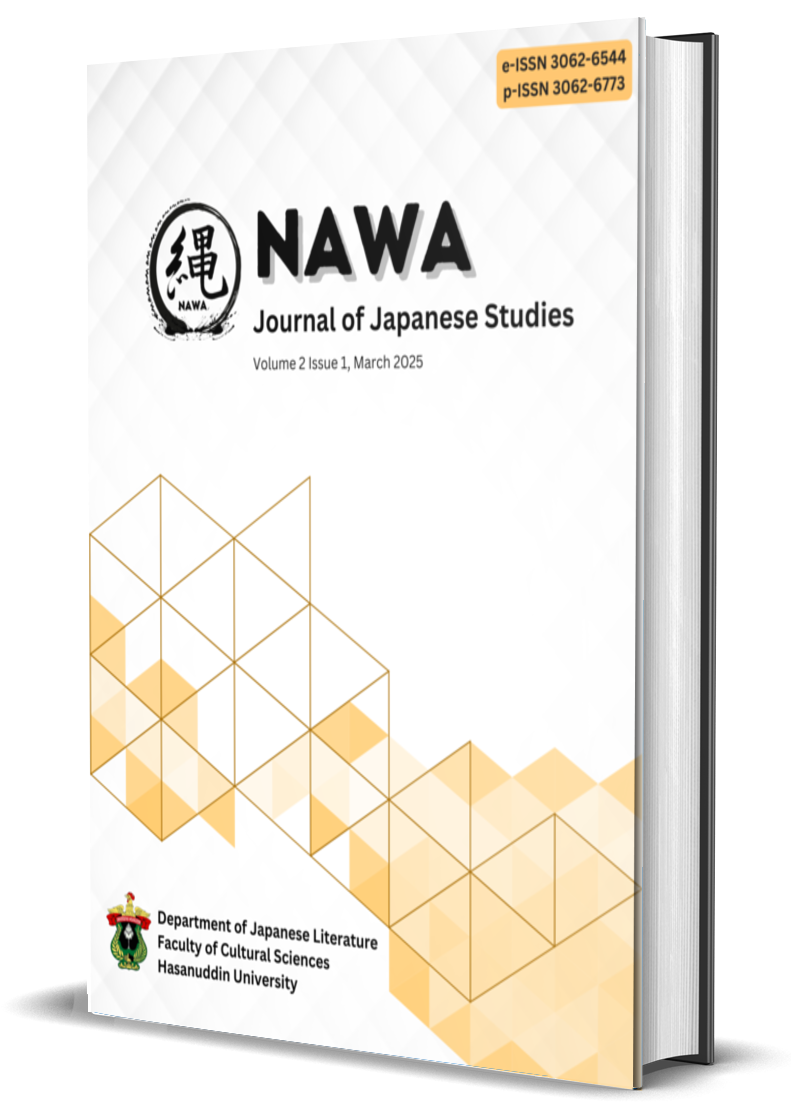Figurative Language and Its Emotional Impact in YOASOBI's The Book 1 Lyrics
A Semantic Approach
DOI:
https://doi.org/10.69908/nawa.v2i1.43302Keywords:
figurative language, semantics, metaphor, song lyrics, YOASOBIAbstract
This study analyses the use of figurative language in The Book 1 album lyrics by YOASOBI through a semantic approach. Figurative language, including metaphor, personification, simile, and hyperbole, is crucial in enhancing song lyrics' emotional depth and artistic expression. This research explores how these figurative elements contribute to meaning-making and emotional engagement in the songs. A qualitative descriptive-analytical method focused on semantic analysis of selected lyrics. The data consist of seven songs from the album The Book 1, which were analysed through document analysis to identify patterns of figurative language. Each instance of metaphor, personification, simile, and hyperbole was categorized based on its linguistic structure and contextual function within the lyrics. The findings reveal that metaphors in YOASOBI’s lyrics establish strong symbolic imagery by connecting abstract concepts with concrete objects. Personification is used to attribute human qualities to non-human entities, intensifying emotional resonance. Simile explicitly compares two distinct elements to clarify feelings, while hyperbole amplifies emotions to create dramatic effects. These devices collectively enrich the meaning of the lyrics, allowing listeners to experience a deeper emotional connection to the songs. The study concludes that YOASOBI’s use of figurative language enhances their music's aesthetic and emotive aspects, making their lyrics more impactful and immersive.
References
Baa, S., Wardani, S. B., Iskandar, Weda, S., & Arafah, B. (2023). Lexical metaphors in Westlife’s selected song lyrics. XLinguae, 16(1), 132–154. https://doi.org/10.18355/XL.2023.16.01.10
Hermintoyo, M. (2018). Kalimat Metaforis Sebagai Sarana Estetika dalam Lirik Lagu nDangdut. Nusa: Jurnal Ilmu Bahasa Dan Sastra, 13(3), 380. https://doi.org/10.14710/nusa.13.3.380-389
Juliana, J., Anggraini, R., & Ardytha, A. (2023). Analysis of Metaphorical Expressions Used in Johnny Cashs’ Song Lyrics. Edumaspul: Jurnal Pendidikan, 7(2), 5963–5968. https://doi.org/10.33487/edumaspul.v7i2.7493
Keraf, G. (2009). Diksi dan gaya bahasa: Komposisi lanjutan I. Gramedia.
Kridalaksana, H. (2011). Kamus Linguistik (Cetakan ketiga). Jakarta: Gramedia Pustaka Utama.
Lakoff, G., & Johnson, M. (2003). Metaphors we live by: With a new afterword. University of Chicago Press.
Riandi, A. P., & Aditia, A. (2022, September 21). Fakta Menarik YOASOBI yang Tampil di Head in the Clouds Jakarta Halaman all. KOMPAS.com. https://entertainment.kompas.com/read/2022/09/21/160000966/fakta-menarik-yoasobi-yang-tampil-di-head-in-the-clouds-jakarta
Shotillo Safarovich Shorakhmetov. (2024). The Power of Metaphor: Exploring the Impact of Figurative Language in Literature. Texas Journal of Philology, Culture and History, 28, 11–14. https://doi.org/10.62480/tjpch.2024.vol28.pp11-14
Simarmata, C. C., Herman, H., & Silalahi, D. E. (2021). Figurative Language Used In Selena Gomez’s Song Lyrics: A Semantic Analysis. JEELL (Journal of English Education, Linguistics and Literature) English Department of STKIP PGRI Jombang, 8(1), 183. https://doi.org/10.32682/jeell.v8i1.2127
Sirait, A. L., Siburian, J. Br., Sitompul, I. M., & Rangkuti, R. (2024). A Cognitive Stylistic Analysis Of Pink Floyd’s Song Lyric “Time.” KLAUSA (Kajian Linguistik, Pembelajaran Bahasa, Dan Sastra), 8(1), 40–52. https://doi.org/10.33479/klausa.v8i1.903
Suzuki Osamu “Pangeran Bulan” | Detail Bab—Monogatary.com. (n.d.). Retrieved February 23, 2025, from https://monogatary.com/episode/109217
Thibodeau, P. H., Matlock, T., & Flusberg, S. J. (2019). The role of metaphor in communication and thought. Language and Linguistics Compass, 13(5), e12327. https://doi.org/10.1111/lnc3.12327
Tokugawa, M., Kawabata, Y., Nakamura, A., & Koichi, H. (2007). Kokugo jiten. In Kokugo jiten (6th ed). Sanseidō [三省堂].
Yoasobi, S. (2020, Desember 4). Osamu Suzuki "Pangeran Bulan". Retrieved December 13, 2023, from Monogatary: https://monogatary.com/episode/109217
Published
How to Cite
Issue
Section
License
Copyright (c) 2025 Muh. Haizam Yusri, Taqdir taqdir

This work is licensed under a Creative Commons Attribution-NonCommercial 4.0 International License.








